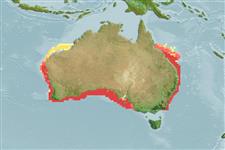Elasmobranchii (hajar och rockor) (sharks and rays) >
Torpediniformes (Electric rays) >
Hypnidae (Coffin rays)
Etymology: Hypnos: Greek, hypnos = sleep (Ref. 45335).
More on author: Shaw.
Environment: milieu / climate zone / depth range / distribution range
Ekologi
marina revassocierade; djupintervall 0 - 240 m (Ref. 9710). Temperate; 18°S - 38°S, 112°E - 155°E (Ref. 114953)
Indo-West Pacific: endemic to Australia.
Length at first maturity / Size / Vikt / Age
Maturity: Lm ?, range 24 - ? cm
Max length : 70.0 cm TL hane/ej könsbestämd; (Ref. 2272); common length : 40.0 cm TL hane/ej könsbestämd; (Ref. 6871)
Occurs inshore and offshore, ranging from the intertidal to 240 m depth (Ref. 9910, 12951). Found buried on sand and mud bottoms; sometimes found stranded out of water by the tide but is capable of surviving for hours (Ref. 9910). Feeds on crabs, worms, and fishes. It was reported that larger fishes, similar size to themselves have been found in the stomachs of Coffin rays, ingested whole through the large gape (Ref. 114953). Ovoviviparous (Ref. 50449). Maximum length probably to 92 cm TL (Ref. 9910). Both sexes mature at 40-48 cm TL; born at ca. 8-11 cm TL (Ref. 114953). A slow-moving species which uses its electric organs to stun prey. Also stuns people when accidentally stepped upon or handled (Ref. 9910).
Life cycle and mating behavior
Könsmognad | Reproduktion | Lek | Ägg | Fecundity | Larver
Exhibit ovoviparity (aplacental viviparity), with embryos feeding initially on yolk, then receiving additional nourishment from the mother by indirect absorption of uterine fluid enriched with mucus, fat or protein through specialised structures (Ref. 50449). Size at birth 8 to 11 cm TL (Ref. 9910).
Compagno, L.J.V., 1999. Checklist of living elasmobranchs. p. 471-498. In W.C. Hamlett (ed.) Sharks, skates, and rays: the biology of elasmobranch fishes. Johns Hopkins University Press, Maryland. (Ref. 35766)
IUCN Red List Status (Ref. 130435)
Human uses
Fiskeri: saknar intresse
Ytterligare information
Age/SizeTillväxtLength-weightLength-lengthLength-frequenciesMorfometriMorfologiLarverLarvdynamikRekryteringAbundansBRUVS
referenserVattenbrukVattenbruksprofilAvelslinjerGenetikElectrophoresesÄrftlighetSjukdomarBehandlingNutrientsMass conversion
MedarbetareBilderStamps, Coins Misc.LjudCiguateraHastighetSimsättGälytaOtolithsHjärnstorlekSyn
Verktyg
Special reports
Download XML
Internet-källor
Estimates based on models
Preferred temperature (Ref.
123201): 15.3 - 22.2, mean 17.4 °C (based on 134 cells).
Phylogenetic diversity index (Ref.
82804): PD
50 = 1.5000 [Uniqueness, from 0.5 = low to 2.0 = high].
Bayesian length-weight: a=0.01000 (0.00244 - 0.04107), b=3.04 (2.81 - 3.27), in cm total length, based on all LWR estimates for this body shape (Ref.
93245).
Trofisk nivå (Ref.
69278): 3.7 ±0.57 se; based on food items.
Fishing Vulnerability (Ref.
59153): Moderate to high vulnerability (48 of 100).
Nutrients (Ref.
124155): Calcium = 2.47 [0.28, 38.57] mg/100g; Iron = 0.157 [0.013, 1.622] mg/100g; Protein = 17.1 [13.0, 20.7] %; Omega3 = 0.302 [0.099, 0.903] g/100g; Selenium = 9.87 [1.75, 49.78] μg/100g; VitaminA = 21.6 [1.7, 276.9] μg/100g; Zinc = 0.479 [0.035, 5.305] mg/100g (wet weight);
